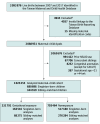Gestational Exposure to Nonsteroidal Anti-Inflammatory Drugs and Risk of Chronic Kidney Disease in Childhood
- PMID: 39714827
- PMCID: PMC11791701
- DOI: 10.1001/jamapediatrics.2024.4409
Gestational Exposure to Nonsteroidal Anti-Inflammatory Drugs and Risk of Chronic Kidney Disease in Childhood
Abstract
Importance: Gestational exposure to nonsteroidal anti-inflammatory drugs (NSAIDs) may increase the risk of adverse fetal kidney outcomes. However, details regarding timing, specific NSAIDs, and long-term childhood kidney outcomes are limited.
Objective: To evaluate the association between gestational exposure to NSAIDs and the risk of chronic kidney disease (CKD) in childhood.
Design, setting, and participants: This national cohort study assessed 1 025 255 children born alive in Taiwan from January 1, 2007, to December 31, 2017, with follow-up until December 31, 2021. Children without valid maternal-child linkage and with incomplete birth information were excluded. Data analysis was performed from November 30, 2023, to April 30, 2024.
Exposure: Maternal prescriptions for NSAIDs from the last menstrual period to birth.
Main outcomes and measures: The main outcome was childhood CKD, including congenital anomalies of the kidney and urinary tract and other kidney diseases. Cox proportional hazards regression models with stabilized inverse probability of treatment weighting (weighted hazard ratio [wHR]) and a robust sandwich estimator were used to estimate the relative risk of NSAID exposure in pregnancy, adjusted for newborn characteristics.
Results: This study included 163 516 singleton-born children (24.0%) whose mothers (mean [SD] age at birth of child, 31.25 [4.92] years) used at least 1 dispensing of an NSAID during pregnancy. Gestational NSAID exposure was significantly associated with a higher risk of childhood CKD (wHR, 1.10; 95% CI, 1.05-1.15). No association was observed between NSAID use and fetal nephrotoxicity in sibling comparisons. Elevated risks were revealed for exposure during the second trimester (wHR, 1.19; 95% CI, 1.11-1.28) and the third trimester (wHR, 1.12; 95% CI, 1.03-1.22) in singleton-born children. Specific NSAID exposures associated with higher CKD risk included indomethacin (wHR, 1.69; 95% CI, 1.10-2.60) and ketorolac (wHR, 1.28; 95% CI, 1.01-1.62) in the first trimester, diclofenac (wHR, 1.27; 95% CI, 1.13-1.42) and mefenamic acid (wHR, 1.29; 95% CI, 1.15-1.46) in the second trimester, and ibuprofen (wHR, 1.34; 95% CI, 1.07-1.68) in the third trimester.
Conclusions and relevance: In this study, gestational exposure to NSAIDs was not associated with a substantial increase in the risk of childhood CKD when comparing between siblings. However, the findings underscore the need for caution when prescribing NSAIDs during pregnancy, particularly indomethacin and ketorolac in the first trimester, mefenamic acid and diclofenac in the second trimester, and ibuprofen in the third trimester, to ensure the safety of the offspring's kidneys.
Conflict of interest statement
Figures


Similar articles
-
Gestational Exposure to Maternal Systemic Glucocorticoids and Childhood Risk of CKD.Am J Kidney Dis. 2024 Aug;84(2):215-223.e1. doi: 10.1053/j.ajkd.2024.01.523. Epub 2024 Mar 11. Am J Kidney Dis. 2024. PMID: 38479460
-
Antidepressant Use During Pregnancy and the Risk of Autism Spectrum Disorder in Children.JAMA Pediatr. 2016 Feb;170(2):117-24. doi: 10.1001/jamapediatrics.2015.3356. JAMA Pediatr. 2016. PMID: 26660917
-
Neonatal and maternal adverse outcomes and exposure to nonsteroidal anti-inflammatory drugs during early pregnancy in South Korea: A nationwide cohort study.PLoS Med. 2023 Feb 27;20(2):e1004183. doi: 10.1371/journal.pmed.1004183. eCollection 2023 Feb. PLoS Med. 2023. PMID: 36848338 Free PMC article.
-
Nonsteroidal antiinflammatory drugs in late pregnancy and persistent pulmonary hypertension of the newborn.Pediatrics. 2013 Jan;131(1):79-87. doi: 10.1542/peds.2012-0496. Epub 2012 Dec 3. Pediatrics. 2013. PMID: 23209104 Free PMC article. Review.
-
Risk estimation of fetal adverse effects after short-term second trimester exposure to non-steroidal anti-inflammatory drugs: a literature review.Eur J Clin Pharmacol. 2019 Oct;75(10):1347-1353. doi: 10.1007/s00228-019-02712-2. Epub 2019 Jul 4. Eur J Clin Pharmacol. 2019. PMID: 31273431
Cited by
-
Kidney Programming and Hypertension: Linking Prenatal Development to Adulthood.Int J Mol Sci. 2024 Dec 19;25(24):13610. doi: 10.3390/ijms252413610. Int J Mol Sci. 2024. PMID: 39769369 Free PMC article. Review.
-
Impact of maternal health on neonatal and long-term kidney outcomes.Pediatr Nephrol. 2025 Jun 3. doi: 10.1007/s00467-025-06771-9. Online ahead of print. Pediatr Nephrol. 2025. PMID: 40459611
-
Pediatric Chronic Kidney Disease: Mind the Gap Between Reality and Expectations.Children (Basel). 2025 May 8;12(5):614. doi: 10.3390/children12050614. Children (Basel). 2025. PMID: 40426793 Free PMC article. Review.
-
Electromagnetic Field Influence on the Bioavailability and Accumulation of Ketoprofen.AAPS PharmSciTech. 2025 Aug 19;26(7):215. doi: 10.1208/s12249-025-03216-2. AAPS PharmSciTech. 2025. PMID: 40830739
References
-
- Quaggin SK. Embryology of embryology of the kidney. In: Levine SA, Brenner BM, eds. Brenner and Rector’s the Kidney. 8th ed. Saunders, Elsevier; 2008:3-24.
MeSH terms
Substances
LinkOut - more resources
Full Text Sources
Medical
Miscellaneous

